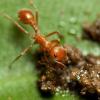Need help identifying the species.
Size 5mm
black bodied with brown legs, gastor is solid black.
pedicel consist of 2 nodes
showing signs of polygynous colony
photo 1: https://imgur.com/j23cwFo
photo 2: https://imgur.com/kSZv5wF
Edited by LIFEsize, June 27 2018 - 11:43 AM.

















